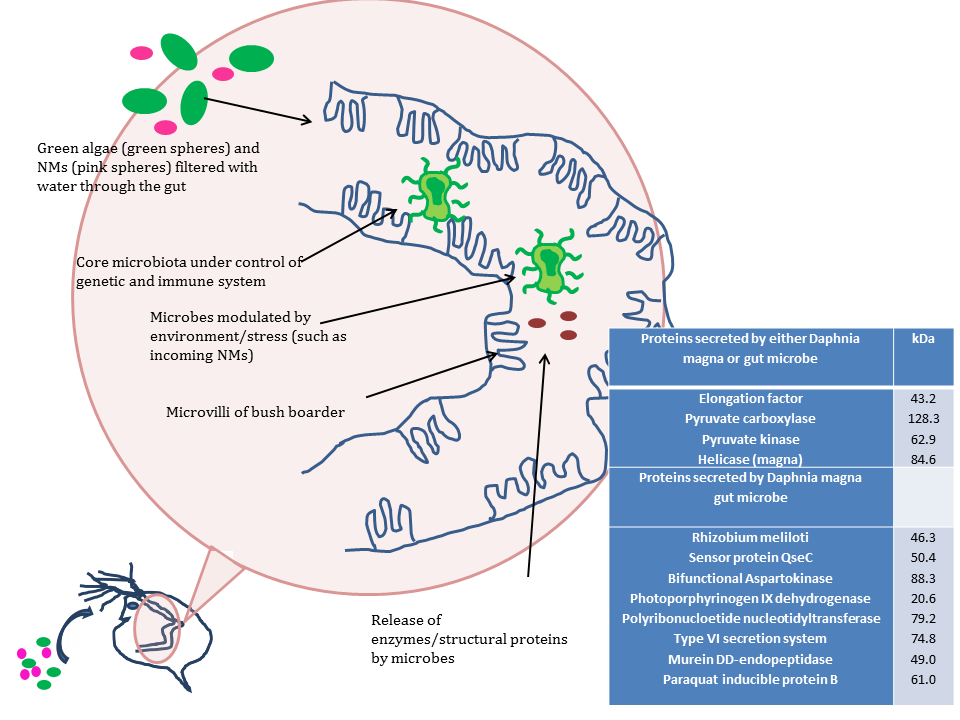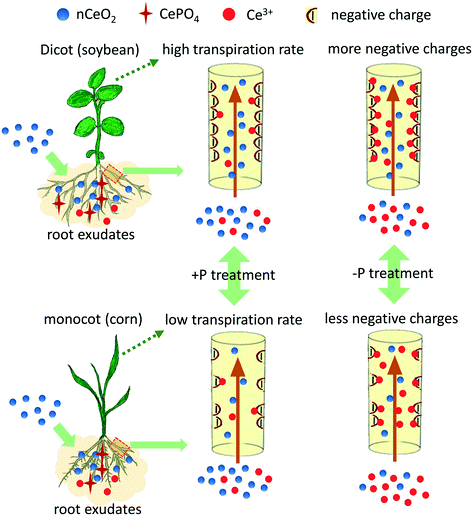Functional Fate Groups: Biota-transformed ENMs
Interaction of ENMs with the specific chemical and biological conditions surrounding or inside biota (organisms) can result in a number of different transformation processes including e.g. dissolution, biogenic formation of new particles, and corona formation.
In most cases, the organism ingests the ENMs which then encounter digestive fluids and often quite acidic conditions, which can drive dissolution. Thus, for example, ENMs that are stable against dissolution at pH7 may dissolve in the gut of daphnia which is approximately pH4.
Organisms may uptake ions released from ENMs in the environment and store them in granules as a result of biogenic formation of a new particulate form.
All environmental compartments have a range of biomolecules present, including natural organic matter (NOM) which is the breakdown material from plants and animals. NOM has a strong interaction with a range of ENMs, and can lead to their stabilisation in the water column, and thus enhance bioavailabilty to organisms (Markiewicz et al., 2018). Corona formation, whereby the surface energy of the ENMs is reduced as it becomes coated by or acquires a layer of biomolecules present in the surroundings, is another transformation that occurs rapidly following contact with and uptake into organisms. Corona formation can slow the rate of dissolution by preventing access of oxygen (for oxidative dissolution processes) or can accelerate the rate of dissolution if there is a strong affinity between a specific protein and the metal ions. The ENMs excreted from organisms have a different corona composition from those particles taken in initially, as a result of exchange of proteins with lower affinity for the surface by those of higher affinity encountered in the gut, some of which can be proteins from the gut microbiome (Nasser et al., 2019 in press). Whether these excreted ENMs are more or less toxic to biota remains a question to be addressed beyond NanoFASE, whose remit was environmental fate and not environmental effects.

Figure: A zoomed in schematic illustration of the gut of Daphnia magna filtering water including green algae and ENMs. These pass through the gut (with microvilli in the bush border for absorbing nutrients), and core (immune system) and environmentally regulated microbiota. They are excreted with an acquired and exchanged corona consisting of proteins arising both from daphnia but also from the daphnia gut microbiome. The figure also shows the characterisation of the specific proteins released into the medium by Daphnia manga neonates after 6 hours and indicates whether these proteins are released by the gut microbiota or Daphnia manga itself. From Nasser et al. (2019, in press).
In the case of plants, the first point of contact is often with the roots, which actively take up nutrients and water from the soil. Given that sewage sludge and nano-enabled fertilisers are routinely applied to soil, there is potential for direct contact and uptake of ENMs by plants. Additionally, like organisms, plant roots secrete a cocktail of small molecules, many of which are reducing agents and can thus chemically transform the ENMs, either inducing dissolution or changes in surface speciation, such as phosphatization. For example, CeO2 ENMs have been found to be transformed into CePO4 particles by a range of plants, and different plant species have different abilities of transforming and translocating the CeO2 NPs with different mechanisms depending on the chemistry of the surrounding solution (+P/−P). Plant xylems and root exudate compositions are both important factors in determining the transformation of nCeO2 and subsequent translocation of Ce species in plants (Zhang et al., 2019).

A schematic illustration of the transformation of CeO2 ENMs (nCeO2 in the figure) on the root surface and the translocation of CeO2 ENMs and Ce3+ions in the root xylem of the dicot and monocot using soybean and corn as examples. Note that if the transformation of CeO2 ENMs into CePO4 ENMs occurred outside the plant much less uptake occurred, as CePO4 ENMs were not taken up. From Zhang et al., 2019.
Read more |
|
|
Briffa SM, Nasser F, Valsami-Jones E, Lynch I (2018) Uptake and impacts of polyvinylpyrrolidone (PVP) capped metal oxide nanoparticles on Daphnia magna: role of core composition and acquired corona. Environ. Sci.: Nano, 2018, 5, 1745-1756. 10.1039/C8EN00063H Markiewicz M, Kumirska J, Lynch I, Matzke M, Köser J, Bemowsky S, Doctor D, Stauber R, Westmeier D, Stolte S (2018) Changing environments and biomolecule coronas: consequences and challenges for the design of environmentally acceptable engineered nanoparticles. Green Chem., 2018, 20, 4133-4168. 10.1039/C8GC01171K Nasser F, Constantinou J, Lynch I. Nanomaterials in the environment acquire an ‘eco-corona’ impacting their toxicity to Daphnia manga– a call for updating toxicity testing policies. J. Proteomics, 2019, in press. Zhang P, Ma Y, Changjian Xie C, Guo Z, He X, Valsami-Jones E, Lynch I, Luo W, Zheng L, Zhang Z (2019) Plant species-dependent transformation and translocation of ceria nanoparticles. Environ. Sci.: Nano, 2019, 6, 60-67. 10.1039/C8EN01089G |
Contact
 Iseult Lynch
Iseult Lynch
Email: i.lynch@bham.ac.uk
